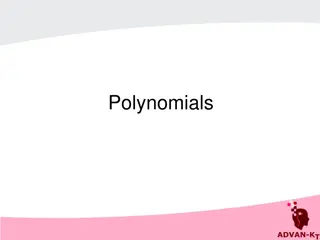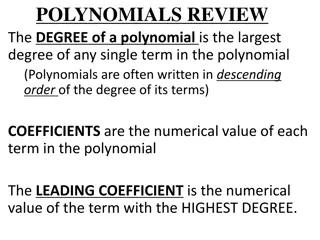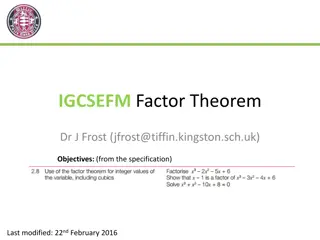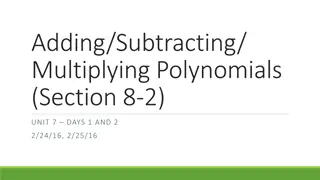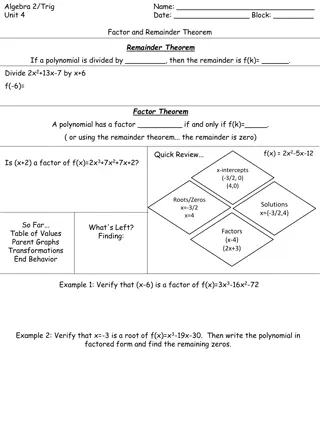Exploring Nonlinear Relationships in Econometrics
Discover the complexities of nonlinear relationships through polynomials, dummy variables, and interactions between continuous variables in econometrics. Delve into cost and product curves, average and marginal cost curves, and their implications in economic analysis. Understand the application of d
2 views • 34 slides
Understanding Galois Theory and Field Extensions
Explore the fundamental concepts of Galois theory, field automorphisms, prime subfields, and field extensions. Learn how symmetries and polynomials play a crucial role in creating new mathematical objects, and understand the significance of field extensions in adjoining roots of polynomials. Delve i
1 views • 14 slides
Understanding Pseudo-Noise Sequences and Applications
Pseudo-Noise (PN) sequences are deterministic yet appear random, with applications in various fields such as communication security, control engineering, and system identification. Generated using shift registers, they exhibit statistical properties akin to noise. Linear and nonlinear feedback shift
1 views • 19 slides
Polynomial Basics: Definitions, Classification, and Operations
Learn the fundamentals of polynomials, including defining polynomials, determining degrees, classifying by terms, writing in standard form, and performing operations like multiplication and division. Understand monomials, binomials, trinomials, coefficients, and degrees of polynomials in a straightf
1 views • 36 slides
Introduction to Arithmetic Operations on Polynomials
This unit focuses on developing an understanding of polynomials in mathematical expressions. You will learn about the parts of a polynomial, polynomial operations, and representing polynomials. The topics cover performing arithmetic operations on polynomials, identifying variables in expressions, le
1 views • 71 slides
Understanding Three-Dimensional Systems of Linear Ordinary Differential Equations
Explore the concepts of three-dimensional linear systems of ordinary differential equations, including techniques for finding eigenvalues and the general solutions. Learn how to determine characteristic polynomials for 3x3 matrices and identify sink, source, and saddle points in 3D systems.
0 views • 20 slides
Understanding Polynomial Functions and Operations
Polynomial functions are mathematical functions in the form of an expression involving variables and coefficients. They can be manipulated through operations like addition, subtraction, multiplication, and division. Learn about polynomial degrees, identifying polynomials, and performing various oper
0 views • 20 slides
Understanding Polynomials: Degrees, Coefficients, and Graphs
Explore the essential concepts of polynomials, including degrees, coefficients, and graph shapes. Learn to identify leading coefficients, degrees, and relationships between polynomial functions and their graphs. Practice finding values of polynomials and analyzing the impact of degrees on the number
2 views • 16 slides
Understanding Increasing and Decreasing Functions
Discover the concept of increasing and decreasing functions, learn how to identify intervals of increase or decrease, and explore the relationship between gradients and function behavior. Dive into differentiation of polynomials and grasp the essence of proving a function's characteristics through a
0 views • 14 slides
Understanding Polynomials and Their Zeroes: A Comprehensive Overview
Explore the world of polynomials, from linear to quadratic to cubic, and understand the concept of degrees, zeroes, and their geometrical meanings. Learn how to determine the value of polynomials at specific points and find the zeroes of different types of polynomials through clear examples and expl
0 views • 14 slides
Understanding Polynomials: Types, Degrees, and Zeroes
Polynomial expressions consist of terms with non-zero coefficients. They can have any number of terms and different degrees. Linear polynomials have a degree of one, quadratic polynomials have a degree of two, and cubic polynomials have a degree of three. Zeroes of a polynomial are the values of the
0 views • 17 slides
Understanding Properties of Rational Functions
Rational functions are expressed as the ratio of two polynomials. The domain of a rational function excludes values that make the denominator zero. Various examples illustrate how to determine the domain and identify asymptotes in rational functions. Vertical asymptotes exist where the denominator i
3 views • 20 slides
Understanding Polynomials and Algebraic Expressions
Dive into the world of algebraic expressions and polynomials, exploring concepts like constants, variables, coefficients, and degrees. Learn how to identify terms, understand polynomial types based on degrees, and solve related mathematical problems.
0 views • 12 slides
Understanding Polynomials in Mathematics
Explore the concept of polynomials in mathematics, including the geometrical meaning of zeroes, the relationship between zeroes and coefficients, and the division algorithm. Learn about the degree of polynomials, value of polynomials, and how to identify and factorize them. Discover algebraic expres
0 views • 46 slides
Football Review Questions and Challenges
Explore a variety of challenging football-themed questions covering topics such as geometry, algebra, and taxes. Test your skills with questions on dimensions, equations, polynomials, geometric sequences, and more. Get ready to score big with these stimulating brain teasers!
1 views • 37 slides
Understanding Eigenvalues and Characteristic Polynomials
Unravel the mystery of eigenvalues and characteristic polynomials through detailed lectures and examples by Hung-yi Lee. Learn how to find eigenvalues, eigenvectors, and eigenspaces, and explore the roots of characteristic polynomials to solve characteristic equations. Dive into examples to discover
2 views • 19 slides
Exploring Polynomials: Zeros, Factors, and Graphs
Understanding polynomials, linear factors, and zeros. Learn how to write and graph polynomial functions, find roots and x-intercepts, apply the Factor Theorem, and plot graphs using zeros and end behaviors.
0 views • 4 slides
Understanding Polynomials and Graphs through Real-World Analogies
Explore the relationship between mountain ranges and polynomials, and learn how to apply the Intermediate Value Theorem to find zeros of polynomial functions. This guide covers concepts like the Interval Value Theorem, sketching graphs of higher-degree polynomials, and constructing tables to analyze
3 views • 85 slides
Exploring Additive Manufacturing: A Revolutionary Technology
Additive manufacturing, commonly known as 3D printing, has witnessed significant advancements since its inception in the 1980s. This technology allows for the creation of three-dimensional objects through various processes like extrusion, binding, and polymerization. With the rise of accessible 3D p
3 views • 14 slides
Insights into Graph Colorings, Chromatic Polynomials, and Conjectures in Discrete Geometry
Delve into the fascinating world of graph colorings, chromatic polynomials, and notable conjectures in discrete geometry. Explore the impact of June Huh in bringing Hodge theory to combinatorics and his proof of various mathematical conjectures. Uncover the significance of the four-color theorem, co
0 views • 17 slides
Understanding Division of Polynomials using Remainder and Factor Theorem
Explore the concept of dividing polynomials to find remainders and factors, illustrated through examples and explanations. Learn how to apply the Remainder and Factor Theorem to determine remainders, factors, and solve related problems. Test your understanding with practical questions.
0 views • 17 slides
Polynomial Division Methods and Examples
Dividing polynomials involves using methods like long division or equating coefficients. By applying these techniques, you can determine whether a polynomial divides exactly or leaves a remainder. The process is similar to long division of numbers, where the dividend is divided by the divisor to obt
0 views • 10 slides
Polynomial Division and Remainder Theorems Explained
Learn how to use long division to find quotients and remainders in polynomial problems. Understand when to use long division or synthetic division. Discover how the remainder theorem works by finding remainders when dividing specific polynomials by different factors. Explore the factor theorem and i
0 views • 6 slides
Polynomial and Synthetic Division Techniques
Learn how to perform polynomial division using long division and synthetic division methods. Understand how to divide polynomials by other polynomials or binomials, utilize the Remainder Theorem and Factor Theorem, and apply these concepts through detailed examples.
0 views • 41 slides
Factorization Methods and Factor Tables in Mathematics
Explore the techniques of factorization through Tic-Tac-Toe method and factor tables. Learn how to find pairs of numbers that multiply to a given result, factor polynomials correctly, and understand the importance of factoring in mathematics concepts. Engage with visual representations and step-by-s
0 views • 12 slides
Understanding the Relationship Between Work and Energy
Work and energy are closely related concepts in physics, where work involves the transfer of energy when a force is applied to move an object in the same direction. The equation for work is given by Work (joules) = Force (newtons) x Distance (m), and power represents the rate at which work is done,
0 views • 7 slides
Lower Bounds for Small Depth Arithmetic Circuits
This work explores lower bounds for small-depth arithmetic circuits, jointly conducted by researchers from MSRI, IITB, and experts in the field. They investigate the complexity of multivariate polynomials in arithmetic circuits, discussing circuit depth, size, and the quest for an explicit family of
0 views • 114 slides
New Extension of the Weil Bound for Character Sums
Tali Kaufman and Shachar Lovett present a new extension of the Weil bound for character sums, providing applications to coding theory. The Weil bound offers insights into the behavior of low-degree polynomials, distinguishing between structured and random-like functions. This extension has implicati
0 views • 28 slides
Insights into Polynomials Vanishing on Cartesian Products and the 3POL Problem
This joint work explores polynomials vanishing on Cartesian products, focusing on the 3POL problem involving three sets of points and a 6-variate polynomial. It discusses the running time of solving the explicit 3POL problem and compares it to the well-studied 3SUM problem in theoretical computer sc
0 views • 29 slides
Year 12 Autumn Scheme of Learning for St. Anthony's and St. Aidan's 6th Form
Explore the comprehensive Year 12 Autumn Scheme of Learning for St. Anthony's and St. Aidan's 6th Form, covering topics such as algebraic manipulation, quadratic equations, simultaneous equations, graphs, statistical sampling, differentiation, integration, and statistical hypothesis testing. Dive in
0 views • 13 slides
Understanding Polynomial Division Methods
Learn how to divide polynomials using long division and synthetic division techniques. Explore the processes of dividing polynomials by other polynomials or binomials, using the Remainder Theorem, and applying synthetic division to evaluate polynomials. Master the steps with detailed examples and vi
0 views • 14 slides
Newton's Interpolating Polynomials in Mechanical Engineering
Explore Newton's interpolating polynomials in the context of Mechanical Engineering, specifically focusing on numerical methods and interpolation techniques. Dr. Mohamed El-Shazly, an Associate Professor of Mechanical Design and Tribology, guides students through the concepts and applications of New
0 views • 17 slides
Understanding Polynomials: Types and Naming Conventions
Delve into the world of polynomials with definitions, examples, and explanations of how they are named based on the number of terms they contain. Learn about monomials, binomials, trinomials, and general polynomials, along with insightful images to aid your understanding.
0 views • 33 slides
Understanding Forces: Types, Effects, and Measurement
Forces are interactions between objects that can be measured using spring scales in Newtons. They can be contact or non-contact, balanced or unbalanced, and include various types like tension, friction, magnetic, gravitational, electrostatic, and elastic spring force. Understanding forces helps expl
0 views • 4 slides
Polynomials Operations: Adding, Subtracting, Multiplying - Unit 7 Days 1 and 2
Dive into the world of polynomial operations in this engaging unit covering adding, subtracting, and multiplying polynomials. Explore methods to combine like terms, distribute negative signs, and apply polynomial operations to solve problems. Practice sorting gumballs with like terms and creating nu
0 views • 23 slides
Understanding Forces and Equilibrium in Physics
Forces in physics can be categorized into contact forces and field forces, measured in units like Newtons (N). Inertia, mass, weight, and equilibrium are fundamental concepts in understanding the behavior of objects under different conditions. An object in motion stays in motion unless acted upon by
0 views • 15 slides
Understanding Polynomial Factor and Remainder Theorems
Exploring the Factor and Remainder Theorems in algebra, including examples on verifying factors, finding roots, applying the Rational Root Test, and determining zeros of polynomials. Learn how to factor polynomials, find remaining zeros, and analyze coefficients to uncover the complete factorization
0 views • 6 slides
Understanding Zeroes of Polynomials - Grade 9 Chapter 2
Zeroes of a polynomial are the values of the variable that make the polynomial equal to zero. This concept is explored in Grade 9 Chapter 2, where students learn how to find the zeroes of a polynomial by equating it to zero. Through examples like p(x) = x - 4, students understand how to determine th
0 views • 10 slides
Addenda to Casas-Alvero Conjecture: Polynomial Derivatives and Common Roots.
In this research work, the Casas-Alvero conjecture is explored, focusing on polynomials and their derivatives, and the common roots they share. The study delves into the normalization of roots under various transformations, using p-adic methods and Gröbner bases. Noteworthy findings include implica
0 views • 24 slides
Understanding Forces and Their Applications
Forces are pushes or pulls that can cause objects to speed up, slow down, change direction, or shape. They are measured in newtons (N) using a newtonmeter. Various types of forces include contact, tension, electrostatic, friction, and gravitational forces. Forces always occur in pairs, with equal an
0 views • 46 slides






